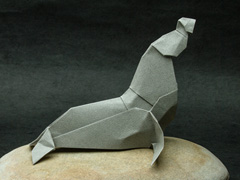Zeppelin
2010
This model completes the Origami from Space series (at least until I think of another). A lot of experimentation went into the design. It uses a modified approach to the polar symmetry layout. Only 2/3 of the paper is used in the main airship hull, the rest is for the gondola.
Bull Walrus
2010
Every year the American Museum of Natural History in New York puts on a fantastic origami Holiday Tree, featuring lots of great origami from around the world. One year not too long ago the theme was "folding the museum" and I contributed several arctic marine mammals, including this Bull Walrus, inspired by dioramas in the museum's famous "whale room". I developed this model from my seal base. It features a color-change tusk when folded from two-sided paper.
Diagrammed in: Origami Animal Sculpture
Narwhal
2010
The Narwhal lives in the waters of the Arctic Ocean. One of the strangest of the whales, their most distinctive feature is a long, spiraled ivory tusk on the male of the species, which can grow to be a third of the body length. The exact purpose of the tusk is unknown. Narwhals are awesome!
Diagrammed in: Origami Animal Sculpture
Elephant Seal
2010
Another gigantic arctic marine mammal, elephant seals' heads have pendulous proboscises that give them their name. My Elephant Seal shares a similar approach to my Walrus, and was in fact designed for the same exhibit. I strove to capture the animal's stance while roaring. Seals and Walruses are subjects that lend themselves to a curved, sculptural approach.
Diagrammed in: Origami Animal Sculpture
Dual Color Stellated Octahedron
2010
Single-sheet stellated polyhedra are pretty advanced but the color change brings it to a whole 'nuther level of complexity. The first challenge was to work out how to achieve the arrangement of alternating colors. I needed two corners to come to the center like a blintz but offset. Working out the amount of offset for the grid to be the right size was the key problem. It turns out the angle is 67.5 degrees, which is 3/4 of 90 degrees and easily derived. It also has a slope of 3/2, which is also easily derived from a square grid. From this I was able to work out the arrangement of the squares in the inner rotated grid and the outer triangular grid areas, which correspond to the blintzed flaps. The 3/2 slope made was convenient because the grid is has an integer relation of the unit the whole. Each square of the grid has a length of 2/13 the edge of the paper, as you can see in the crease pattern.
Single-sheet stellated polyhedra are pretty advanced but the color change brings it to a whole 'nuther level of complexity. The first challenge was to work out how to achieve the arrangement of alternating colors. I needed two corners to come to the center like a blintz but offset. Working out the amount of offset for the grid to be the right size was the key problem. It turns out the angle is 67.5 degrees, which is 3/4 of 90 degrees and easily derived. It also has a slope of 3/2, which is also easily derived from a square grid. From this I was able to work out the arrangement of the squares in the inner rotated grid and the outer triangular grid areas, which correspond to the blintzed flaps. The 3/2 slope made was convenient because the grid is has an integer relation of the unit the whole. Each square of the grid has a length of 2/13 the edge of the paper, as you can see in the crease pattern.
The grid of triangles and squares is a complement to the Cairo Tessellation. This mesh is the dual of the other. If you draw a dot in the center of each cell of the pentagon of the Cairo grid and connect them all, you get this pattern. Five cells converge at each vertex. In the other pattern all the cells were the same shape, but either three or four cells converged at a vertex. The two of them make a nice set.





